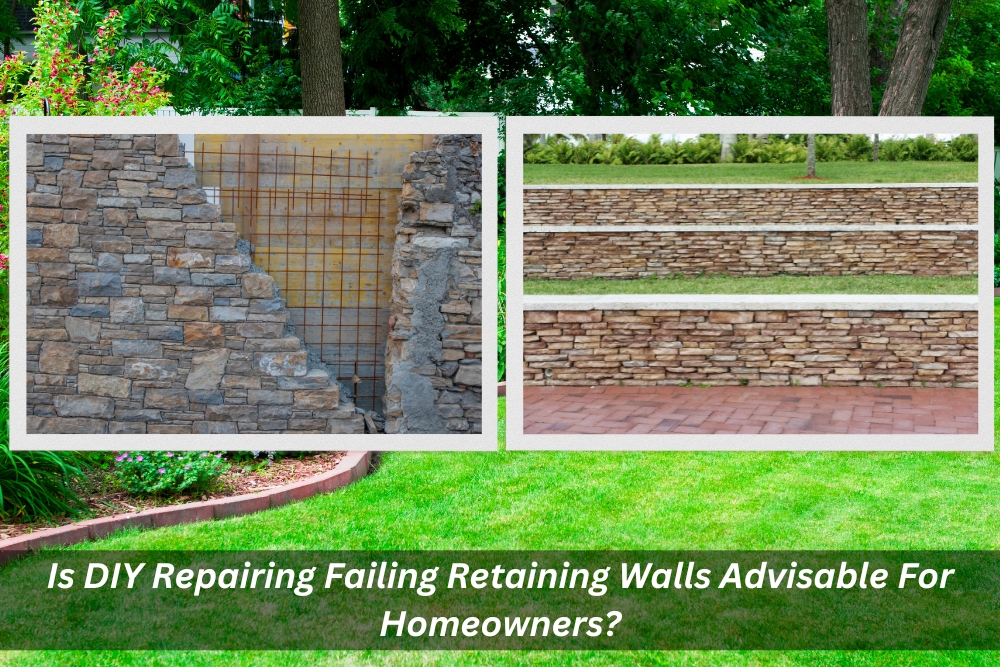
Retaining walls is crucial in preventing soil erosion, managing water runoff, and creating levelled spaces in a landscape. Over time, however, these structures can succumb to various factors, leading to failure. When faced with a failing retaining wall, homeowners may consider a do-it-yourself (DIY) repair approach. But is DIY repairing failing retaining walls advisable? Let’s delve into the details.
What is a retaining wall?
Before delving into the repair aspect, it’s essential to understand what a retaining wall is. It is a construction designed to retain soil and avert erosion or collapse. Frequently employed in landscapes with uneven topography, these structures establish level surfaces for gardens, driveways, or other practical areas.
Why do retaining walls fail?
Retaining walls can fail due to various reasons, and understanding these factors is crucial for effective repair decisions. Some common causes of retaining wall failure include:
- Poor drainage: Inadequate drainage is a significant contributor to failure. When water accumulates behind the wall, it increases the pressure on the structure, leading to potential collapses or bulges.
- Improper construction: If the wall is not built correctly, with insufficient reinforcement or incorrect materials, it is more prone to failure. Poor construction practices can compromise the wall’s stability.
- Soil erosion: Over time, soil erosion can undermine the foundation of a retaining wall, causing it to shift or tilt. This is especially true in areas with heavy rainfall or improper grading.
- Freeze-thaw cycles: In colder climates, the freeze-thaw cycle can be detrimental. The expansion and contraction of water in the soil can exert significant pressure on the wall, leading to cracks and instability.
- Vegetation growth: The roots of nearby plants and trees can penetrate the wall, causing damage over time. This is particularly common if the wall lacks proper barriers or if invasive plant species are present.
Remember, a failing retaining wall can sometimes be a symptom of a larger problem. If tree root removal is necessary, consider professional stump grinding services to ensure a complete and lasting repair.
What are the signs that your retaining wall is failing?
Recognising the early signs of a failing retaining wall is crucial for timely intervention. Keep an eye out for these indicators:
- Visible leaning: If the wall is visibly leaning or tilting, it’s a clear sign of potential failure. This can result from issues with the foundation or soil pressure.
- Cracks in the wall: Small cracks may appear innocuous, but they can be indicative of underlying problems. Regularly inspect the wall for any visible cracks, especially if they are widening over time.
- Pooling water: The accumulation of water behind the wall suggests drainage issues. Poor drainage can lead to increased pressure, increasing the risk of failure.
- Bulging or bowing: If the wall is bulging or bowing outward, it’s a sign of structural stress. This could be caused by excessive soil pressure or inadequate reinforcement.
- Sinking or settling: A sinking or settling wall indicates issues with the foundation. This can compromise the wall’s stability and effectiveness.
Should you DIY repair a failing retaining wall?
While the prospect of saving money through a DIY repair may be tempting, tackling a failing retaining wall without the necessary expertise can lead to more significant issues. Consider the following factors before deciding to DIY:
- The extent of damage: Assess the extent of damage to your retaining wall. If the issues are minor, such as small cracks, and you have experience with masonry work, DIY repairs may be feasible.
- Technical knowledge: Successful repairs require a good understanding of engineering principles and construction techniques. If you lack the technical knowledge, it’s advisable to consult with professionals.
- Safety concerns: Working on retaining walls involves heavy materials and sometimes working at heights. If safety is a concern or if you’re uncomfortable with such tasks, it’s best to leave the repairs to experts.
- Time and effort: Restoring a wall can demand a significant amount of time and physical effort. Before choosing a do-it-yourself (DIY) approach, assess whether you have the necessary time and energy to commit to the project.
What are the pros and cons of DIY retaining wall repair?
Before embarking on a DIY repair, it’s crucial to weigh the pros and cons to make an informed decision. While the prospect of saving money and taking pride in a hands-on approach is appealing, there are potential pitfalls to consider.
Pros of DIY retaining wall repair:
- Cost savings: One of the primary advantages of DIY repair is cost savings. By handling the project yourself, you can avoid labour costs associated with hiring professionals.
- Personal satisfaction: Successfully repairing your retaining wall can be personally rewarding. The sense of accomplishment and pride in a job well done can be fulfilling.
- Flexibility in timing: DIY projects allow for flexibility in timing. You can work on the repair at your own pace, fitting it into your schedule as needed.
- Learning experience: Undertaking a DIY repair provides an opportunity to learn new skills and gain a deeper understanding of your landscape’s structural elements.
Cons of DIY retaining wall repair:
- Lack of expertise: Retaining wall failures often requires a level of engineering knowledge and construction expertise that many homeowners may not possess. DIY attempts without the necessary expertise can lead to subpar repairs and potential safety hazards.
- Safety risks: Working on walls involves handling heavy materials and sometimes working at heights. Without proper safety measures and equipment, DIY repairs can pose significant risks.
- Potential for further damage: Inexperienced DIY repairs may address visible issues but neglect underlying causes. This can lead to a cycle of recurring problems and potentially exacerbate the damage over time.
- Time-consuming: DIY repairs can be time-consuming, especially for those with limited experience. The time invested may outweigh the initial cost savings, especially if the repair could be done more efficiently.
- Unforeseen challenges: Retaining wall repairs can uncover unforeseen challenges, such as hidden structural issues or the need for specialised equipment. Professionals are equipped to handle such challenges efficiently.
Tips for DIY retaining wall repair
If you decide to proceed with a DIY retaining wall repair, follow these tips to increase the likelihood of success:
- Assess the soil: Understand the type of soil behind the wall and address any drainage issues. Proper drainage helps alleviate pressure on the retaining wall.
- Use the right materials: Make sure to select materials appropriate for the specific structural type of retaining wall you have. Different structural types of retaining walls demand distinct materials, and using the wrong ones may jeopardise the effectiveness of the repair.
- Address the root cause: Identify and address the root cause of the failure. Whether it’s poor drainage or soil erosion, fixing the underlying issue is crucial for a lasting repair.
- Follow guidelines: Adhere to proper construction guidelines and techniques. This includes using the right amount of reinforcement and ensuring a solid foundation.
- Seek professional advice: Even if you choose to DIY, consulting with a professional engineer or retaining wall expert can provide valuable insights and guidance.
When to hire a professional retaining wall contractor
In many cases, hiring a professional retaining wall contractor is the wisest choice. Consider seeking professional help when:
- Structural integrity is compromised: If the retaining wall’s structural integrity is significantly compromised, professional intervention is necessary to ensure a durable and safe repair.
- Lack of technical expertise: If you lack the technical expertise required for proper wall repair, hiring professionals is the safest option.
- Large-scale repairs: For extensive repairs involving major reconstruction or reinstallation, professional contractors have the expertise and equipment necessary for the job.
- Legal and permit requirements: Some retaining wall repairs may require permits or compliance with local regulations. Professionals can navigate these requirements efficiently.
- Time constraints: If time is a critical factor, professionals can complete the repair more quickly than a DIY approach, reducing the risk of further damage.
Conclusion
In summary, the decision to DIY repair a failing retaining wall should be based on a thorough assessment of the damage, your technical knowledge, and the scope of the repair. While minor issues may be manageable for experienced homeowners, significant structural problems are best left to professional retaining wall contractors. Prioritise safety, address the root cause of the failure, and, if in doubt, seek professional advice to ensure a successful and lasting repair. Remember, a well-maintained retaining wall not only enhances the aesthetics of your landscape but also serves its vital function of preventing soil erosion and promoting a stable environment. Consider consulting a qualified arborist for urgent or complex tree removal needs in Melbourne. If you’ve identified signs of a failing retaining wall in your landscape, it’s time to take action and ensure the longevity of your outdoor space.
If you’ve identified signs of a failing retaining wall in your landscape, it’s time to take action and ensure the longevity of your outdoor space. All Green Gardening & Landscaping stands ready to assist you in addressing retaining wall issues with expertise and professionalism. Our team understands the intricacies of retaining wall repair, offering various services to suit your specific needs. Whether it’s a minor cosmetic fix or a more complex structural issue, our experienced professionals can provide the necessary expertise to ensure a lasting solution. Don’t let a failing retaining wall compromise the safety and aesthetics of your landscape. Contact All Green Gardening & Landscaping today, and let us help you restore the stability and beauty of your outdoor environment. Your satisfaction and the health of your landscape are our top priorities.
